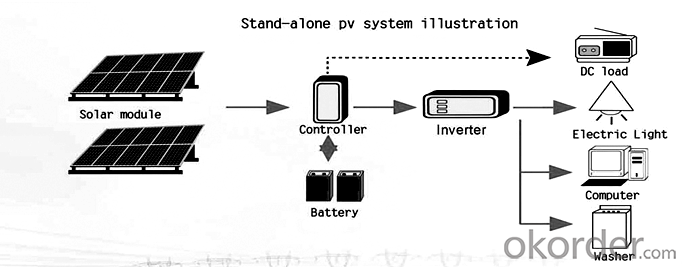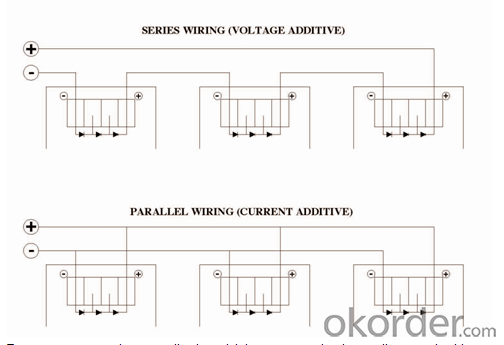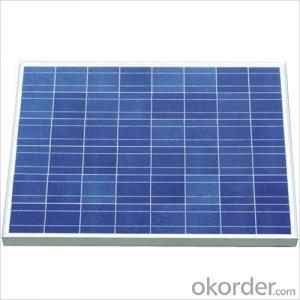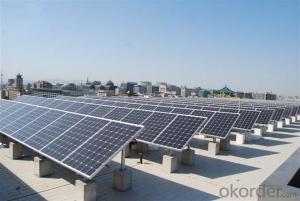295W Solar Panel Silicon Polycrystalline
- Loading Port:
- Nanjing
- Payment Terms:
- TT OR LC
- Min Order Qty:
- 200000 watt
- Supply Capability:
- 20000000 watt/month
OKorder Service Pledge
OKorder Financial Service
You Might Also Like
INTRODUCTION
This installation Manual contains essential information for the electrical and mechanical installation that your must know before installing CUSTOMER PV modules. This also contains safety information you need to be familiar with .All the information described in this manual are the intellectual property of CNBM and based on the technologies and experiences that have been acquired and accumulated in the long history of CUSTOMER. This document does not constitute a warranty, expressed or implied.
CUSTOMER does not assume responsibility and expressly disclaims liability for loss, damage, or expense arising out of in anyway connected with installation, operation, use or maintenance of the PV modules. No responsibility is assumed by CUSTOMER for any infringement of patents or other rights of third parties that may result from use of PV module.
CUSTOMER reserves the right to make changes to the product, specifications or installation manual without prior notice.
WORK PRINCIPLE

COMPONENTS

WIRING
To ensure proper system operation to maintain your warranty, observe the correct cable connection polarity(Figures 1&2) when connecting the modules to a battery or to other modules. If not connected correctly, the bypass diode could be destroyed.
PV modules can be wired in series to increase voltage. Connect wires from the positive terminal of one module to the negative of the next module. Figure shows modules connected in series .

GROUDING
All PV models must be grounded by electrical connection of the module frames to ground. Please be careful in arranging the system ground so that the removal of one module from the circuit will not interrupt the grounding of any other modules.
The modules should be grounded to the same electrical point as described below.
Each PV module has a hole on the side frame of either a bolt, nut and washer grounding the module to the frame, a ground lug fastened by bolt or screw, or appropriate screw(hardware not provided).An example of acceptable ground connection using a bolt, nut and washer retaining a ground lug is shown in figure 3,in a connection of this type, the hardware(such as a toothed locked washer/star washer) must score the frame surface to make positive electrical contact with the frame. The ground wire must be considered within the requirement of local and regulation at the site of installation.


- Q:i trying to make a solar panel. right now i dont have money to go and buy a copper sheet. so can i make it out of aluminum foil. if there is a way please tell me how. and what do i use for wires. i making this to charge batteries.
- Presumably you plan to create a focused parabolic reflector and have it oriented to heat the bottom of a pan. It will obviously need to be larger than the pan in order to gather sunlight outside of the pan's shadow, as well as gather and concentrate enough light onto the bottom of the pan to heat its contents. If you use black paint on the bottom of the pan, make sure it's high temperature paint (available at auto supply stores, often used to paint engine blocks and exhaust manifolds). Yes, a cover on the pan will make it hotter.
- Q:Can solar panels be installed on a carport?
- Yes, solar panels can be installed on a carport. In fact, carports are an ideal location for solar panel installation as they provide ample space, unobstructed sunlight, and can also serve as a shade provider for parked cars.
- Q:Can solar panels be used in remote areas without access to the grid?
- Yes, solar panels can be used in remote areas without access to the grid. Solar panels generate electricity by capturing sunlight and converting it into usable energy. This renewable energy source is particularly useful in off-grid locations as it provides a sustainable and independent power supply. With advancements in solar technology and the availability of battery storage systems, solar panels can effectively meet the energy needs of remote areas, even during nighttime or periods of low sunlight. This makes solar panels an ideal solution for powering homes, businesses, and infrastructure in remote locations without grid connectivity.
- Q:Can solar panels be used in areas with high levels of noise or vibration?
- Yes, solar panels can be used in areas with high levels of noise or vibration. Solar panels are designed to withstand various environmental conditions, including noise and vibration. However, it is important to ensure that the installation is properly secured and that the panels are not subjected to excessive shaking or impact, which could potentially damage their performance or structural integrity.
- Q:i have a fountain system that has a small electric pump. its made to be close to a house but i want it across the driveway and i dont want to run electrical over there.is there a small solar panel that i can get fairly inexpensive to mount on a nearby tree and be able to plug the pump into it?
- You will need more than a small solar panel to run a pump continuously, unless you don't mind that the pump only comes on during the day while the sun is out. st you need to know what the power demands are of the pump in question. Not only do you need to know the rate of the power draw from the pump, but you will also have to calculate how much power the pump will draw from your solar system every day. You will have to factor in that the sun doesn't shine brightly every day, of course there's also night, so you will need a storage battery, charging system to go along with your solar panel. Now most pumps like the one you described are 20vac. Most solar panels, the batteries, the chargers are 2vdc. In order to get 20vac you will need an inverter. Once again, you will have to make sure that the inverter you get can handle the demands of the pump. A solar system that actually works for you takes some carefull planning, it's not something that you can just hang from a tree. None of what I just descibed will be inexpensive by my definition, so if it were me, I'd dig a trench across the driveway, install some direct bury cable on a GFCI circuit out of my main power panel save a bundle.
- Q:Can solar panels be used in areas with high levels of salinity or brackish water?
- Yes, solar panels can be used in areas with high levels of salinity or brackish water. While exposure to saltwater can potentially cause corrosion and reduce the efficiency of solar panels over time, there are various measures that can be taken to mitigate these effects. These include selecting corrosion-resistant materials, applying protective coatings, and regular maintenance. Additionally, advancements in solar panel technology have led to the development of more robust and durable panels that can withstand harsh environments, including areas with high salinity or brackish water.
- Q:Can solar panels be installed in urban areas with limited space?
- Yes, solar panels can be installed in urban areas with limited space. There are various options available such as rooftop solar panels, building-integrated photovoltaics, and solar canopies that can be used to maximize the utilization of available space in urban areas. Additionally, advancements in solar technology have led to the development of more compact and efficient solar panels, making it easier to install them in limited spaces.
- Q:How do solar panels impact the local economy?
- Solar panels can have a positive impact on the local economy in several ways. Firstly, the installation and maintenance of solar panels create job opportunities, stimulating employment and income generation within the community. Additionally, the use of solar energy reduces reliance on imported fossil fuels, contributing to energy independence and reducing energy costs for both households and businesses. This can lead to increased disposable income, which can be reinvested in the local economy, supporting local businesses and promoting economic growth. Moreover, solar panels attract investment and contribute to the development of a clean energy sector, positioning the community as a hub for renewable energy innovations and attracting more businesses and investments in the long run.
- Q:Hi! I bought a Coleman 2 vdc cooler that pulls 9 amps. What size solar panel and amp-hour battery do I need? I only open it 3 times a day. It will hold about 3 gals of milk.
- If it pulls 9 amps continuously, that's 08 watts/hour or about 2.5 kwh/day. If it only pulls half that (does it cycle?) it's about .2 kwh/day. You only want to drain a lead-acid battery 50% or so, so you'll want a 5 or 2.5 kwh battery pack. A typical setup for the 5 kwh would be two L-6 batteries in series, and for the 2.5 kwh you could use 2 T-05 batteries in series. This does not account for days of cloud. If you regularly have cloudy days, size the battery pack for two or three days of use with no input (2-3 x the sizes given above). To charge them, you typically want panels that will charge your battery at least 5% of its capacity per hour (C/20). For 2 volt nominal panels that's 0 amps for the T-05 or 20 amps for the L-6 batteries. It's good to have more than that for battery life (it cuts down on what's called stratification), so you'll want probably 50-200 watts of panels for the T-05 and 300-400 for the L-6. You'll also need a charge controller. Peltier coolers are very inefficient. You'll save money by using a regular mini-fridge and an inverter. Most mini-fridges only draw 50 watts or so, so you're talking 600 watt-hours for a 50% duty cycle. This means two T-05 batteries will give you two days of use and you'll only need 20-50 watts of panel. DK
- Q:when solar panels have served their purpose, what is done with them?
- Usually recycled. By the time You need your Solar panel Refurbished, Technology will have created better, more efficient and cheaper types..
1. Manufacturer Overview |
|
|---|---|
| Location | |
| Year Established | |
| Annual Output Value | |
| Main Markets | |
| Company Certifications | |
2. Manufacturer Certificates |
|
|---|---|
| a) Certification Name | |
| Range | |
| Reference | |
| Validity Period | |
3. Manufacturer Capability |
|
|---|---|
| a)Trade Capacity | |
| Nearest Port | |
| Export Percentage | |
| No.of Employees in Trade Department | |
| Language Spoken: | |
| b)Factory Information | |
| Factory Size: | |
| No. of Production Lines | |
| Contract Manufacturing | |
| Product Price Range | |
Send your message to us
295W Solar Panel Silicon Polycrystalline
- Loading Port:
- Nanjing
- Payment Terms:
- TT OR LC
- Min Order Qty:
- 200000 watt
- Supply Capability:
- 20000000 watt/month
OKorder Service Pledge
OKorder Financial Service
Similar products
New products
Hot products
Related keywords





























